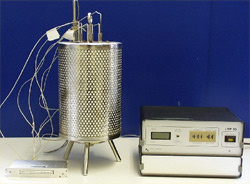The auto-ignition temperature in an air stream is the lowest temperature at which a dust sample reacts with the oxygen in the air and/or decomposes exothermally. In the Grewer-oven the test substance and a same quantity of graphite powder as reference substance are heated up at a rate of 1°C/min by means of a hot air stream which is blown through them. The surrounding temperature at which the test sample temperature starts to rise faster than of the inert reference sample, is taken as the (relative) auto-ignition temperature of the sample.
Température d'auto-inflammation relative
This test is designed to determine the relative auto-ignition temperature of a product in a hot air-stream. It is applied to products which are subjected to elevated temperatures in an air-stream for a short period of time (e.g. spray drier, circulating air tray drier, fluidised bed drier, mill etc.). With this test, the permissible inlet temperature of the drier can be derived.
The auto-ignition of the product tested occurs by reaction with the oxygen in the air and/or by exothermic decomposition. The same test may be done in a nitrogen-stream instead of an air-stream: hence the exothermic decomposition temperature is found. If both results are compared, the influence of the oxygen in the air can be clearly distinguished.
It is understood that auto-ignition means the ignition of combustible matter in air subjected to uniform heat. The temperature of the surrounding atmosphere (storage temperature) which initiates auto-ignition after self-heating of the product is called the auto-ignition temperature.
The self-heating of the product is caused by an already evident oxidation in air at storage temperature. Such oxidation will liberate certain amount of heat per time and mass. If the heat is not entirely transmitted to the surroundings, an increase in the temperature of the product will occur. The end result is auto-ignition.
The Grewer-oven has six vertical cylindrical cavities, in which small wire mesh baskets (volume 8 cm³) are placed. One of the baskets contains an inert reference sample, e.g. graphite powder. The other five can contain test samples. The test sample and the reference sample are heated at a rate of 1°C/min in an air-stream of 100 to 120 l/h up to 350°C. The surrounding temperature at which the test sample temperature starts to rise faster than of the inert reference sample, is taken as the (relative) auto-ignition temperature of the sample.
If the temperature of the test sample rises to 400°C or more, the result is termed auto-ignition; if not it is termed self-heating.
The test is performed on the sample fraction having a particle size less than 250 micron.
The process of self-heating is strongly dependent on the sample size and the duration of thermal exposure. A larger test volume will lead to auto-ignition at lower ambient temperatures. The auto-ignition temperature determined in the Grewer-oven is not to be used in all circumstances as a safe limit for the operation of thermal processes, but is useful as a reference for the comparison of the thermal behaviour of different substances.
- VDI-Richtlinien 2263, Blatt 1: Untersuchungsmethoden zur Ermittlung von sicherheitstechnischen Kenngrössen von Stäuben (1990)
- Kühner AG, Safety testing equipment: Screening tests – Test procedures
- W. Bartknecht, Staub Explosionen: Ablauf und Schutzmassnahmen (1987)
- R.K. Eckhoff, Dust explosions in the process industries (1997)
- Handboek explosiebeveiliging, Kluwer-Editorial

